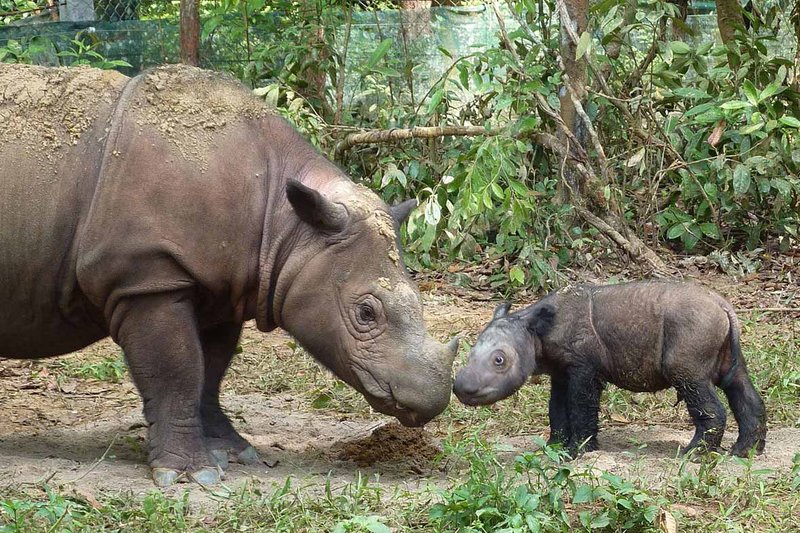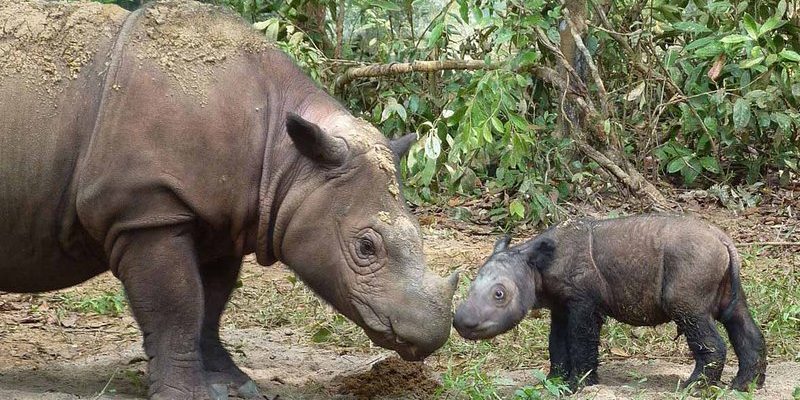
In the wild, Sumatran rhinoceroses have a unique approach to raising their young, interweaving instincts, nurture, and an understanding of their environment. This process is as delicate as it is vital, especially since these animals are critically endangered. Today, I’ll walk you through the ways these remarkable creatures raise their offspring, navigating the challenges they face in their natural habitats.
Understanding Sumatran Rhinoceros Family Dynamics
Sumatran rhinoceroses are generally solitary animals, but when it comes to raising their young, a mother’s role becomes paramount. After a gestation period of about 15 to 16 months, a mother rhino gives birth to a single calf, usually weighing around 50 to 60 pounds. This initial stage of life is incredibly vulnerable, much like a newborn baby for humans.
The mother dedicates herself entirely to the calf during the first few years. She provides nourishment through her milk and teaches essential skills. It’s during these early years that the bond between the mother and calf develops, influencing how the young rhino will behave in the wild. For instance, the calf learns crucial lessons about foraging for food and recognizing potential threats.
As time goes on, the mother begins to allow her young one a bit more independence, stepping back to let the calf explore its surroundings. This gradual increase in freedom helps the calf learn how to navigate the dense forests and rocky terrains of its habitat—an essential skill for survival.
The Role of Nutrition in Raising Calves
Nutrition is a vital component of the raising process for Sumatran rhinoceroses. The mother’s milk is rich in nutrients, helping the calf grow strong during its formative months. After about six months, they begin to nibble on solid food, such as leaves, fruits, and bark, but the mother still provides milk for up to three years.
Here’s an interesting tidbit: Sumatran rhinos are browsers rather than grazers, meaning they choose to eat leaves and shrubs rather than open grasslands. This behavior is tied to their anatomy and environment. As the mother introduces her calf to various plants, she’s also teaching the little one what is safe to eat. This knowledge is crucial for young rhinos, as the right diet will significantly affect their health and growth.
As the calf matures, its diet will diversify based on what the mother has shown it. This nurturing process mirrors how children learn from their parents about food and nutrition, emphasizing the importance of a balanced diet.
Teaching Survival Skills Through Play
When it comes to raising their young, playtime is not just for fun; it’s a crucial part of learning. Calves often engage in playful wrestling and mock charging with their mother. This play isn’t just for entertainment—it teaches the young rhino vital survival skills.
Through these playful interactions, the calf learns how to use its body, develop strength, and understand social dynamics. For instance, during a playful engagement, a calf might instinctively practice defensive moves, preparing it for future encounters with predators or rival rhinos. It’s the same idea as kids playing tag; they’re developing their agility and coordination, all while having a blast.
Mothers also demonstrate how to find water sources and creating a safe space for resting. By engaging in these playful yet educational activities, the calf builds confidence, which is essential for its later years in the wild.
Facing Threats Together
Raising young in the wild isn’t without its dangers. Sumatran rhinoceroses face threats from predators, habitat loss, and human interference. Mothers are instinctively protective, often making decisions that prioritize their calf’s safety.
For example, if a mother senses danger—like the presence of a poacher—she may lead her calf into thicker brush or away from the area entirely. The connection between mother and calf means that they communicate through a series of sounds and movements, helping the calf understand when to stay close and when to be cautious.
Additionally, the mother teaches the calf how to use its senses. By observing her reactions to different environmental cues—like the scent of potential threats or changes in sounds in the forest—the young one learns to be alert and aware, skills that can save its life in the wild.
The Importance of Longevity and Independence
As the young rhino grows, the relationship between mother and calf gradually shifts. By the time the calf is about two or three years old, it’s time for some tough love. The mother starts to encourage independence, allowing the young rhino to venture further away and forage on its own.
This transition is essential for the calf’s development. It must learn to be independent, as mother rhinoceroses won’t stay with their young indefinitely. In fact, once the new calf is born, the mother may kick the older calf out of her territory to focus on the new arrival.
Independence isn’t just about physical survival; it also involves social skills. Young rhinos who navigate their environment and social interactions without their mother’s constant guidance tend to adapt better to their surroundings and are more likely to thrive in the wild.
Raising young in the wild is a delicate dance for Sumatran rhinoceroses. The way they nurture their calves reflects an intricate balance of instinct, learning, and survival strategies. Each step of the way—from birth to independence—is crucial for ensuring the future of the species.
As these magnificent creatures face increasing threats from habitat loss and poaching, understanding their parenting behaviors helps emphasize the importance of conservation efforts. Protecting both mothers and their young is essential for nurturing the next generation of Sumatran rhinoceroses, ensuring that they continue to roam the forests of Sumatra for years to come.
So, next time you think about parenting in the animal kingdom, remember the Sumatran rhinoceros and their unwavering dedication to their young—as challenging as it may be, it’s a beautiful testament to the bond of family in the wild.

